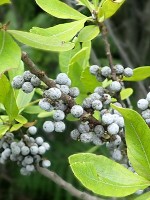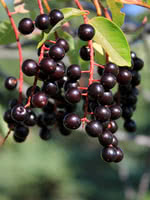Mon-Fri 9am - 5pm Mountain time
Western Chokecherry vs Northern Bayberry
Myrica pensylvanica
Prunus virginiana var. demissa
NOT AVAILABLE THIS SEASON - MIGHT RETURN
SOLD OUT
Northern Bayberry makes an excellent hedge or feature shrub. It will retain its leaves in warmer climates but drops them in colder areas. They produce blue-grey berries that have a wax coating on them that can be used to make candles or soaps.
In colder hardiness zones the leaves turn an attractive orange to red colour in the fall, making it a striking addition to your landscape.
Northern Bayberry is native to Nova Scotia and tolerates both drought and wet conditions. It is also a nitrogen fixer that tolerates poor soil conditions.
Western Chokecherry is a shrub or small tree commonly used for farmstead and field windbreaks.
It produces white flowers in the spring and edible dark purple fruit that matures between September and October. Its cherries are great for making for making jams, jellies or wine, but are not very palatable for raw eating.
Northern Bayberry Quick Facts
Western Chokecherry Quick Facts
Toxicity: Warning: The wax from bayberry fruit is considered toxic and may be carcinogenic.
Toxicity: toxic to horses, cattle, etc.)

